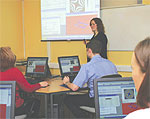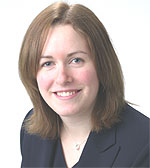
Optima has made a business out of teaching people to use Zemax products.
Optima began life in 1994 as an optical components shop, trading out of the bedroom of its founders Denise Evans and Mark Nicholson, in Bishop's Stortford. Evans had previously worked for several optical companies and was general manager of Spindler and Hoyer. Her idea was to compete with the likes of Melles Griot and Thorlabs, but she wanted to specialise in the more upmarket and higher margin product lines.
The original product range was optical mounts and so on, but it was difficult to compete on hardware with the volume players. She started looking for software products to sell, because there was the opportunity to add value through things like technical support and training.

The Zemax software in action.
A few years earlier, Zemax had been founded by Ken Moore, who was a research scientist at the University of Arizona with a background in software development. He had created a program for lens design that worked on a PC, for his own use. This happened after his PhD supervisor passed an optical design consultancy on to him, even though he had no real experience in optics. He had looked around for a software package to help him and, finding that they all cost thousands of dollars, sat down and wrote his own code as a cheaper option. He then found that colleagues kept asking to use it, and then to add more features to it. When a company offered to buy the program from him he realised that there was a market for his program, so he formed Zemax to commercialise it. He won a SPIE technology achievement award for his work. It made a big impact on the market, because it was written deliberately to work on Windows, with a spreadsheet-style user interface that gave it a short learning curve.
Evans says: 'I knew that it was a good program from my time as general manager at Spindler and Hoyer, when I was involved with the launch of its WinLens program, so it seemed the obvious product to sell. The main thing that I thought it had over its competitors was the intuitive way it worked, coupled with the incredible value it offered - the price was low for the number of features you got. Zemax was also a very supportive supplier, letting us have software keys for training purposes, as well as literature. It always delivered the goods on time, and the company always gave answers to any questions we had. We all liked the program ourselves and enjoyed using it.'
Evans secured a Europe-wide distribution deal. She had experience of working with other companies, where the prices of products varied in different countries. Some products were simply not available in particular countries. She saw the emerging single European market as a way to offer a single price - and single level of service - across the whole continent from one company. This would offer better value to Zemax, while also showing customers that they were not being 'ripped off'.
Evans says: 'I was being charged a much higher price. So we wanted to use the single market to our advantage - something the other representatives were not doing - mostly because they were set up in the old days when there were many borders and barriers to European trade.
'We also wanted to use email and the web to give Optima an advantage. In 1994 these things were fairly new to the general public, but our customers all had access to a computer and wanted to use the web and email more. Also, we thought it would be fun and we liked it ourselves. I think we were the first UK electro optics representative to have a website. Because of email and the web we could offer a high level of tech support fairly easily across Europe, and cheaply too. This was just not possible before.
'Also, the whole point of selling this type of software is that you really need to employ good engineers so the customers are happy and will keep placing orders. The pan-European model works with Zemax because across Europe the market is large enough that we can employ highly-qualified people. If we had stuck to the UK, we would be more limited in the level of tech support we could offer.'
Optima continued to sell other products, including other software and hardware such as interferometers and wavefront sensors. But it soon became clear that the company was making most of its revenue from Zemax sales. The other products were shipping in smaller volumes, but ended up taking a disproportionate amount of their time.
Last year Mark Nicholson was offered the job of vice-president of operations at Zemax, which inevitably brought the two companies closer together. Evans decided that it made sense to concentrate all the company's resources on supporting Zemax, and the other product lines were dropped.
Zemax has proved popular in a wide variety of companies, some of whom are specialists and just want a tool for their designers. Others are companies that suddenly find that they have to put some thought into the optical design of a product and their engineers have to learn how to do it.

Optima's general manager, Jenny Warwick.
Optima's general manager, Jenny Warwick, says: 'We have customers who have a few lenses in their design and want to see what kind of imaging they will get, through to multi-national companies doing R&D on products ranging from telescopes to mobile phone cameras and photocopiers.
'Zemax lets you model how the light goes through any system that has mirrors or lenses. You can optimise the shape and size of the lenses and mirrors to get the best image, or you can model the illumination systems to know the distribution of the light. That is where Zemax becomes unique, because it has a sequential or non-sequential mode. One mode will model imaging and the other will model illumination with the same interface. Other products have two separate interfaces to do these two functions and you have to get the data from one to the other if you want to do both jobs.'
Most of Optima's activity is selling Zemax software and the technical support that goes with it. The support contact ../includes the usual product upgrades, but it also allows customers to pick the brains of the Optima engineers about how to get their project working. Zemax is a complex piece of software to drive. Because of this, as time has progressed, a greater emphasis has been put on training courses. A typical 'introduction' course is five days long, as is the advanced course.
Warwick says: 'After people have been using the software for a while, they typically want to know in much greater depth how the calculations are done and how to use all the features. We also have another course on how to use the non-sequential illumination side of the package.
'Often we have a few people with deep optical knowledge who just want to learn how to use the interface. But the vast majority are transferring over from another field like electronics. We have to be careful to balance it between teaching Zemax and teaching enough optics so they can understand what the package is doing.'
Optima has discovered that there is a huge demand for training in basic optics. It is well known that many physicists, even those with advanced degrees, have scant knowledge of the practicalities of optics and there are very few postgraduate courses that can turn out fully-trained optical engineers. Optima decided to start filling that gap by offering courses on optical design principles.
Warwick says: 'Quite often, smaller companies have some kind of optics in their products. They decide they need to change those optics, so they buy a copy of Zemax and send someone on the course. When they go back to work, they become the optical designer. We find those people need quite a lot of support, because they have been given a lot of responsibility.
'We have started to add other courses to the range, because people do not have the basic optics knowledge they want and need. We have had public courses on the design and engineering of optical systems, and next year we will have courses on optical design principles, because those are the areas that people do not have the knowledge about. We have found that there are very few other courses in optical design, even though there are something like 2000 Zemax users around Europe.'
Courses are also being offered to teach people about what is going on 'under the hood' of Zemax. Warwick says many users, especially research scientists, really want to understand what the programme is actually doing, rather than just using the features and taking them for granted.
Warwick says that, while her company does a lot of demand-generation marketing work itself, the product's reputation has been spreading of its own accord. She says that once someone learns to use Zemax, they tend to want to take that knowledge with them when they change companies. There is a lot of indirect repeat business from people who have used Zemax at university, and then want it when they start work. Others, when they move to a new company, send their whole department to do the training course.
The move into fundamental training in optics will almost certainly have a spin-off benefit in Zemax seat sales, as anyone who finds they need to start understanding optical design will have very few other opportunities to learn.

